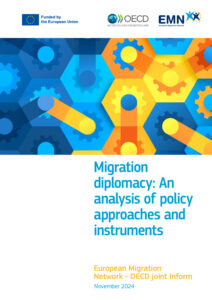This joint-inform by the European Migration Network (EMN), and Organisation for Economic Co-operation and Development (OECD), sheds light on the role of migration diplomacy in fostering international cooperation for effective migration management.
The inform highlights the diplomatic tools, practices, and challenges involved in migration diplomacy across EMN Member and Observer countries with examples from OECD countries, focusing on good practices, challenges, and impacts in managing cross-border movement.
Migration diplomacy has emerged as a crucial component of international migration policy among EMN Member and Observer Countries. Seventeen of these countries integrate it into their migration affairs, whilst six others report limited engagement in migration diplomacy, largely due to their strategic alignment with the European Union’s initiatives, as well as limited national resources. For these countries, participating in EU-level migration diplomacy initiatives offers a more practical approach to international migration affairs than pursuing independent bilateral agreements.
The inform details a variety of instruments commonly used in migration diplomacy, such as bilateral agreements, memoranda of understanding (MoUs), declarations of intent, and the appointment of special envoys or diplomatic representatives. Bilateral agreements are among the most widely adopted instruments, addressing specific issues like readmission and visa facilitation or encompassing broader migration partnership agreements.
Though migration diplomacy can streamline international cooperation on migration, EMN Member and Observer Countries also encounter significant challenges in negotiating these agreements. Obstacles include the need for effective coordination at different levels of government, resource allocation, and the creation of sustainable frameworks that acknowledge each partner’s capabilities.
